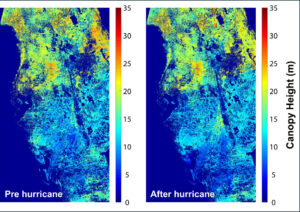The long record of Landsat data (since 1972) is helping scientists Sean Healey and Zhiqiang Yang of the Rocky Mountain Research Station (U.S. Forest Service) study the long-term impact of the May 18, 1980, eruption of Mount St. Helens. With Landsat data for 8 years before the eruption, and 40 years since, they have calculated the percent tree cover for each year, watching as vegetation grows back.
Video credit: Matt Radcliff, NASA Goddard Space Flight Center
It has been forty years since Mount St. Helens erupted on May 18, 1980, in southwestern Washington, near the Oregon border. Fifty-seven people lost their lives in the disaster, and huge swaths of the surrounding forest were levelled. Both before and after the eruption, Landsat satellites were taking regular observations of the area, and their data is being used to study how forests recover from a very large disturbance.
Sean Healey is a research ecologist with the Rocky Mountain Research Service, United State Forest Service. Along with his colleague Zhiqiang Yang, Sean has been studying the forests in the area to determine how the structure of the forest changes with disturbances. He is interesteed in knowing the changes in carbon stocks and the dynamics of forest recovery.
Sean and Zhiqiang have used Landsat data to create predictions of the percent tree cover as the trees and other vegetation regrows. The Landsat Program is a series of Earth-observing satellite missions jointly managed by NASA and the U.S. Geological Survey (USGS).
Sean remarks, “I can’t imagine what it would be like to describe what this volcano did without having a time series of Landsat. There is no other asset in the sky that can show us what Landsat does in terms of the effect of this eruption and also the effect of recovery following the eruption.”
Landsat satellites have been consistently gathering data about our planet since 1972. They continue to improve and expand this unparalleled record of Earth’s changing landscapes for the benefit of all.
Related Reading:
+ Mount St. Helens, NASA Earth Observatory
+ 40 Years of Forest Recovery, NASA Goddard Media Studios






